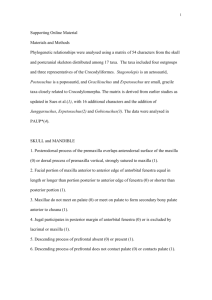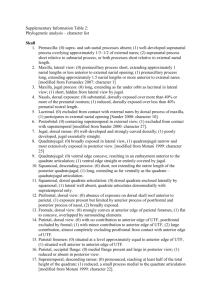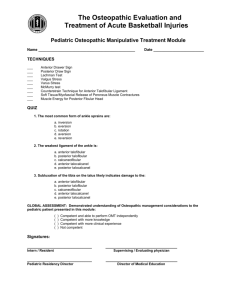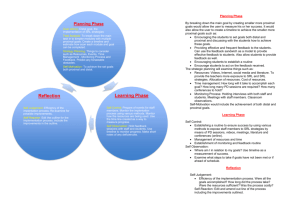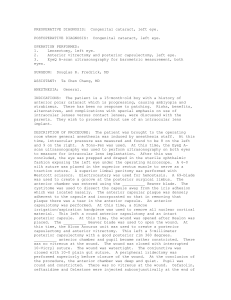A basal troodontid dinosaur from China
advertisement
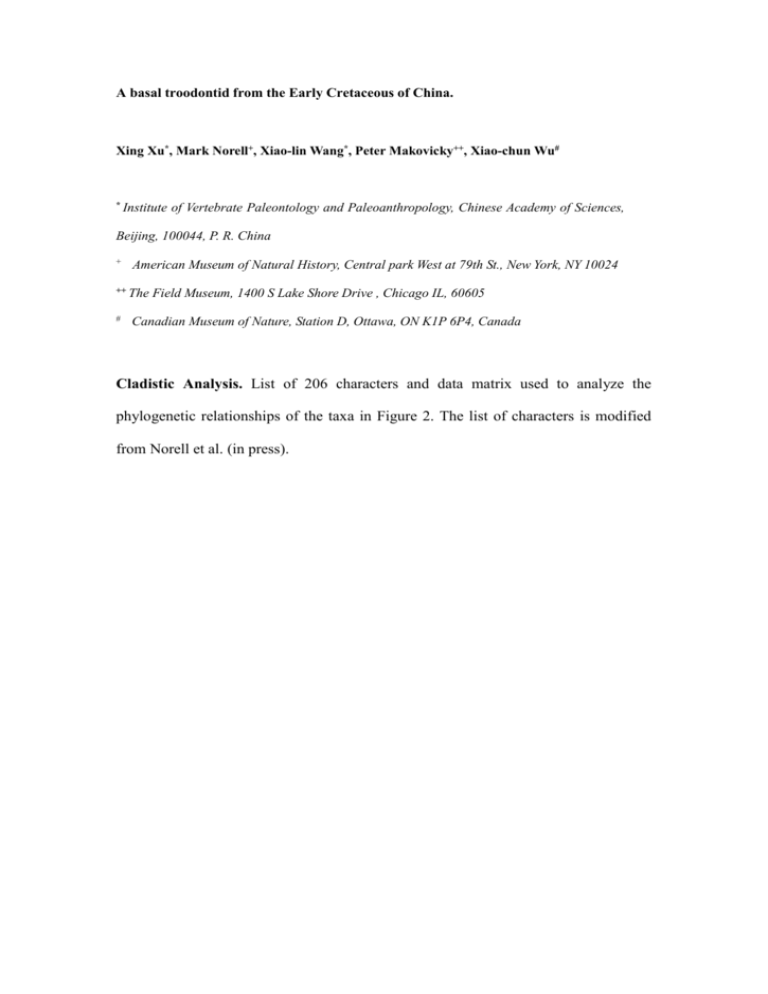
A basal troodontid from the Early Cretaceous of China. Xing Xu*, Mark Norell+, Xiao-lin Wang*, Peter Makovicky++, Xiao-chun Wu# * Institute of Vertebrate Paleontology and Paleoanthropology, Chinese Academy of Sciences, Beijing, 100044, P. R. China + ++ # American Museum of Natural History, Central park West at 79th St., New York, NY 10024 The Field Museum, 1400 S Lake Shore Drive , Chicago IL, 60605 Canadian Museum of Nature, Station D, Ottawa, ON K1P 6P4, Canada Cladistic Analysis. List of 206 characters and data matrix used to analyze the phylogenetic relationships of the taxa in Figure 2. The list of characters is modified from Norell et al. (in press). Character list 1. Vaned feathers on forelimb symmetric (0) or asymmetric (1). The barbs on opposite sides of the rachis differ in length; in extant birds, the barbs on the leading edge of flight feathers are shorter than those on the trailing edge. 2. Orbit round in lateral or dorsolateral view (0) or dorsoventrally elongate (1). It is unclear that the eye occupied the entire orbit of those taxa in which it is keyhole shaped. 3. Anterior process of postorbital projects into orbit (0) or does not project into orbit (1). 4. Postorbital bar parallels quadrate, lower temporal fenestra rectangular in shape (0) or jugal and postorbital approach or contact quadratojugal to constrict lower temporal fenestra (1). 5. Otosphenoidal crest vertical on basisphenoid and prootic, and does not border an enlarged pneumatic recess (0) or well developed, crescent shaped, thin crest forms anterior edge of enlarged pneumatic recess (1). This structure forms the anterior, and most distinct, border of the “lateral depression” of the middle ear region (see Currie, 1985; Currie and Zhao, 1992) of troodontids and some extant avians. 6. Crista interfenestralis confluent with lateral surface of prootic and opisthotic (0) or distinctly depressed within middle ear opening (1). 7. Subotic recess (pneumatic fossa ventral to fenestra ovalis) present (0) or absent (1) 8. Basisphenoid recess present between basisphenoid and basioccipital (0) or entirely within basisphenoid (1) or absent (2). 9. Base of cultriform process not highly pneumatized (0) or base of cultriform process (parasphenoid rostrum) expanded and pneumatic (parasphenoid bulla) (1). 10. Basipterygoid processes ventral or anteroventrally projecting (0) or lateroventrally projecting (1). 11. Basipterygoid processes well developed, extending as a distinct process from the base of the basisphenoid (0) or processes abbreviated or absent (1). 12. Basipterygoid processes solid (0) or processes hollow (1). 13. Depression for pneumatic recess on prootic absent (0) or present as dorsally open fossa on prootic/opisthotic (1) or present as deep, posterolaterally directed concavity (2). The dorsal tympanic recess referred to here is the depression anterodorsal to the middle ear on the opisthotic, not the recess dorsal to the crista interfenestralis within the middle ear as seen in Archaeopteryx lithographica, Shuuvuia deserti and Aves. 14. Accessory tympanic recess dorsal to crista interfenestralis absent (0) small pocket present (1) or extensive with indirect pneumatization (2). According to Witmer (1990), this structure may be an extension from the caudal tympanic recess, although it has been interpreted as the main part of the caudal tympanic recess by some authors (e.g., Walker, 1985). 15. Caudal (posterior) tympanic recess absent (0) present as opening on anterior surface of paroccipital process (1) or extends into opisthotic posterodorsal to fenestra ovalis, confluent with this fenestra (2). 16. Maxillary process of premaxilla contacts nasal to form posterior border of nares (0) or maxillary process reduced so that maxilla participates broadly in external naris (1) or maxillary process of premaxilla extends posteriorly to separate maxilla from nasal posterior to nares (2). 17. Premaxillary symphysis acute, V-shaped (0) or rounded, U-shaped (1). 18. Secondary palate formed by premaxilla only (0) or by premaxilla, maxilla, and vomer (1). 19. Palatal shelf of maxilla flat (0) or with midline ventral ‘tooth-like’ projection (1) 20. Pronounced, round accessory antorbital fenestra absent (0) or present (1). A small fenestra, variously termed the accessory antorbital fenestra or maxillary fenestra, penetrates the medial wall of the antorbital fossa anterior to the antorbital fenestra in a variety of coelurosaurs and other theropods. 21. Tertiary antorbital fenestra (fenestra promaxillaris) absent (0) or present (1). 22. Antorbital fossa without distinct rim ventrally and anteriorly (0) or with distinct rim composed of a thin wall of bone (1). A rim is most strongly developed in the therizinosauroid Erlikosaurus andrewsi (Clark et al., 1994) but is nearly absent in ornithomimosaurs. 23. Narial region apneumatic or poorly pneumatized (0) or with extensive pneumatic fossae, especially along posterodorsal rim of fossa (1). 24. Jugal and postorbital contribute equally to postorbital bar (0) or ascending process of jugal reduced and descending process of postorbital ventrally elongate (1). 25. Jugal tall beneath lower temporal fenestra, twice or more as tall dorsoventrally as it is wide transversely (0) or rod-like (1). 26. Jugal pneumatic recess in posteroventral corner of antorbital fossa present (0) or absent (1). 27. Medial jugal foramen present on medial surface ventral to postorbital bar (0) or absent (1). 28. Quadratojugal without horizontal process posterior to ascending process (reversed “L” shape) (0) or with process (i.e., inverted ‘T’ or ‘Y’ shape) (1). 29. Jugal and quadratojugal separate (0) or quadratojugal and jugal fused and not distinguishable from one another (1). 30. Supraorbital crests on lacrimal in adult individuals absent (0) or dorsal crest above orbit (1) or lateral expansion anterior and dorsal to orbit (2). 31. Enlarged foramen or foramina opening laterally at the angle of the lacrimal, absent (0) or present (1). 32. Lacrimal anterodorsal process absent (inverted ‘L’ shaped) (0) or lacrimal ‘T’ shaped in lateral view (1) or anterodorsal process much longer than posterior process (2). Ordered. 33. Prefrontal large, dorsal exposure similar to that of lacrimal (0) or greatly reduced in size (1) or absent (2). Ordered. 34. Frontals narrow anteriorly as a wedge between nasals (0) or end abruptly anteriorly, suture with nasal transversely oriented (1). 35. Dorsal surface of parietals flat, lateral ridge borders supratemporal fenestra (0) or parietals dorsally convex with very low sagittal crest along midline (1) or dorsally convex with well developed sagittal crest (2). 36. Parietals separate (0) or fused (1). 37. Descending process of squamosal parallels quadrate shaft (0) or nearly perpendicular to quadrate shaft (1). 38. Descending process of squamosal contacts quadratojugal (0) or does not contact quadratojugal (1). 39. Dorsal process of quadrate single headed (0) or with two distinct heads, a lateral one contacting the squamosal and a medial head contacting the braincase (1). 40. Quadrate vertical (0) or strongly inclined anteroventrally so that distal end lies far forward of proximal end (1). 41. Quadrate solid (0) or hollow, with depression on posterior surface (1). 42. Foramen magnum subcircular, slightly wider than tall (0) or oval, taller than wide (1). See Makovicky and Sues (1998). 43. Occipital condyle without constricted neck (0) or subspherical with constricted neck (1). 44. Paroccipital process elongate and slender, with dorsal and ventral edges nearly parallel (0) or process short, deep with convex distal end (1). 45. Paroccipital process straight, projects laterally or posterolaterally (0) or distal end curves ventrally, pendant (1). 46. Ectopterygoid with constricted opening into fossa (0) or with open ventral fossa in the main body of the element (1). 47. Flange of pterygoid well developed (0) or reduced in size or absent (1). 48. Palatine tetraradiate, with jugal process (0) or palatine triradiate, jugal process absent (1). 49. Suborbital fenestra similar in length to orbit (0) or reduced in size (less than one quarter orbital length) or absent (1). 50. Symphyseal region of dentary broad and straight, paralleling lateral margin (0) or medially recurved slightly (1) or strongly recurved medially (2). 51. Mandible without coronoid prominence (0) or with coronoid prominence (1). 52. Posterior end of dentary without posterodorsal process dorsal to mandibular fenestra (0) or with dorsal process above anterior end of mandibular fenestra (1) or with elongate dorsal process extending over most of fenestra (2) 53. Nutrient foramina on external surface of dentary superficial (0) or lie within deep groove (1). 54. External mandibular fenestra oval (0) or subdivided by a spinous rostral process of the surangular (1). 55. Foramen in lateral surface of surangular rostral to mandibular articulation, absent (0) or present (1). 56. Splenial not widely exposed on lateral surface of mandible (0) or exposed as a broad triangle between dentary and angular on lateral surface of mandible (1). 57. Coronoid ossification large (0) or only a thin splint (1) or absent (2). Ordered. 58. Articular without elongate, slender medial, posteromedial, or mediodorsal process from retroarticular process (0) or with process (1). 59. Retroarticular process short, stout (0) or elongate and slender (1). 60. Mandibular articulation surface as long as distal end of quadrate (0) or twice or more as long as quadrate surface, allowing anteroposterior movement of mandible (1). 61. Premaxilla toothed (0) or edentulous (1). 62. Maxilla toothed (0) or edentulous (1). 63. All maxillary and dentary teeth serrated (0) or some without serrations anteriorly (except at base in S. mongoliensis) (1) or all without serrations (2). Ordered. 64. Dentary and maxillary teeth large, less than 25 in dentary (0) or moderate number of small teeth (25-30 in dentary) (1) or teeth relatively small, and numerous (more than 30 in dentary) (2). 65. Serration denticles large (0) or small (1). Farlow et al. (1991) quantify this difference. 66. Serrations simple, denticles convex (0) or distal and often mesial edges of teeth with large, hooked denticles that point toward the tip of the crown (1). 67. Maxillary and dentary teeth constricted between root and crown (0) or root and crown confluent (1). 68. Dentary teeth evenly spaced (0) or anterior dentary teeth smaller, more numerous, and more closely appressed than those in middle of tooth row (1). 69. Dentaries lack distinct interdental plates (0) or with interdental plates medially between teeth (1). Currie (1995) suggests the interdental plates of dromaeosaurids are present but fused to the medial surface of the dentary, but in the absence of convincing evidence for this fusion we did not recognize this distinction. 70. In cross section, premaxillary tooth crowns sub-oval to sub-circular (0) or asymmetrical (D-shaped in cross section) with flat lingual surface (1). 71. Number of cervical vertebrae: 10 (0) or 12 or more (1) 72. Axial epipophyses absent or poorly developed, not extending past posterior rim of postzygopophyses (0) or large and posteriorly directed, extend beyond postzygapophyses (1). 73. Axial neural spine flared transversely (0) or compressed mediolaterally (1). 74. Epipophyses of cervical vertebrae placed distally on postzygapophyses, above postzygopophyseal facets (0) or placed proximally, proximal to postzygapophyseal facets (1). 75. Anterior cervical centra level with or shorter than posterior extent of neural arch (0) or centra extending beyond posterior limit of neural arch (1). 76. Carotid process on posterior cervical vertebrae absent (0) or present (1). 77. Anterior cervical centra subcircular or square in anterior view (0) or distinctly wider than high, kidney shaped (1). 78. Cervical neural spines anteroposteriorly long (0) or short and centered on neural arch, giving arch an “X” shape in dorsal view (1). 79. Cervical centra with one pair of pneumatic openings (0) or with two pairs of pneumatic openings (1). 80. Cervical and anterior trunk vertebrae amphiplatyan (0) or opisthocoelous (1). 81. Anterior trunk vertebrae without prominent hypapophyses (0) or with large hypapophyses (1). 82. Parapophyses of posterior trunk vertebrae flush with neural arch (0) or distinctly projected on pedicels (1). 83. Hyposphene -hypantrum articulations in trunk vertebrae absent (0) or present (1). 84. Cervical vertebrae but not dorsal vertebrae pneumatic (0) or all presacral vertebrae pneumatic (1). 85. Transverse processes of anterior dorsal vertebrae long and thin (0) or short, wide, and only slightly inclined (1). 86. Neural spines of dorsal vertebrae not expanded distally (0) or expanded to form ‘spine table’ (1). 87. Scars for interspinous ligaments terminate at apex of neural spine in dorsal vertebrae (0) or terminate below apex of neural spine (1). 88. Number of sacral vertebrae: 5 (0) or 6 (1) or 8 or more (2). Ordered. 89. Ventral surface of posterior sacral centra gently rounded, convex (0) or ventrally flattened, sometimes with shallow sulcus (1) or centrum strongly constricted transversely, ventral surface keeled (2). Note that in Alvarezsaurus calvoi it is only the fifth sacral that is keeled, unlike other alvarezsaurids (Novas, 1997). 90. Pleurocoels absent on sacral vertebrae (0) or present on anterior sacrals only (1) or present on all sacrals (2). A pleurocoel may be present on the first sacral in Alxasaurus elesitaiensis, although this area is badly crushed (Russell and Dong, 1993b). Ordered. 91. Last sacral centrum with flat posterior articulation surface (0) or convex articulation surface (1). 92. Caudal vertebrae with distinct transition point, from shorter centra with long transverse processes proximally to longer centra with small or no transverse processes distally (0) or vertebrae homogeneous in shape, without transition point (1). 93. Transition point in caudal series begins distal to the 10th caudal (0) or at or proximal to the 10th caudal vertebra (1). 94. Anterior caudal centra tall, oval in cross section (0) or with box-like centra in caudals I-V (1) or anterior caudal centra laterally compressed with ventral keel (2). 95. Neural spines of caudal vertebrae simple, undivided (0) or separated into anterior and posterior alae throughout much of caudal sequence (1). 96. Neural spines on distal caudals form a low ridge (0) or spine absent (1) or midline sulcus in center of neural arch (2). 97. Prezygapophyses of distal caudal vertebrae between 1/3 and whole centrum length (0) or with extremely long extensions of the prezygapophyses (up to 10 vertebral segments long in some taxa) (1) or strongly reduced as in Archaeopteryx lithographica (2). 98. More than 40 caudal vertebrae (0) or 25-40 caudal vertebrae (1) or no more than 25 caudal vertebrae (2). Ordered. 99. Proximal end of chevrons of proximal caudals short anteroposteriorly, shaft cylindrical (0) or proximal end elongate anteroposteriorly, flattened and plate-like (1). 100. Shaft of cervical ribs slender and longer than vertebra to which they articulate (0) or broad and shorter than vertebra (1). 101. Ossified uncinate processes absent (0) or present (1). 102. Ossified ventral rib segments absent (0) or present (1). 103. Lateral gastral segment shorter than medial one in each arch (0) or distal segment longer than proximal segment (1). 104. Ossified sternal plates separate in adults (0) or fused (1). 105. Sternum without distinct lateral xiphoid process posterior to costal margin (0) or with lateral xiphoid process (1). 106. Hypocleidium on furcula absent (0) or present (1). The hypocleidium is a process extending from the ventral midline of the furcula, and is attached to the sternum by a ligament in extant birds. 107. Acromion margin of scapula continuous with blade (0) or anterior edge laterally everted (1). 108. Anterior surface of coracoid ventral to glenoid fossa unexpanded (0) or anterior edge of coracoid expanded, forms triangular subglenoid fossa bounded laterally by coracoid tuber (1). 109. Scapula and coracoid separate (0) or fused into scapulacoracoid (1). 110. Coracoid in lateral view subcircular, with shallow ventral blade (0) or subquadrangular with extensive ventral blade (1) or shallow ventral blade with elongate posteroventral process (2). 111. Scapula and coracoid form a continuous arc in posterior and anterior views (0) or coracoid inflected medially, scapulocoracoid ‘L’ shaped in lateral view (1). 112. Glenoid fossa faces posteriorly or posterolaterally (0) or laterally (1). 113. Deltopectoral crest large and distinct, proximal end of humerus quadrangular in anterior view (0) or deltopectoral crest less pronounced, forming an arc rather than being quadrangular (1) or deltopectoral crest very weakly developed, proximal end of humerus with rounded edges (2) or deltopectoral crest extremely long (3) or proximal end of humerus extremely broad, triangular in anterior view (4). 114. Anterior surface of deltopectoral crest smooth (0) or with distinct groove or ridge near lateral edge along distal end of crest (1). 115. Olecranon process weakly developed (0) or distinct and large (1). 116. Distal articular surface of ulna flat (0) or convex, semilunate surface (1). 117. Proximal surface of ulna a single continuous articular facet (0) or divided into two distinct fossae separated by a median ridge (1). 118. Lateral proximal carpal (ulnare?) quadrangular (0) or triangular in proximal view (1). The homology of the carpal elements of coelurosaurs is unclear (see, e.g., Padian and Chiappe, 1998) but the large, triangular lateral element of some taxa most likely corresponds to the lateral proximal carpal of basal tetanurans. 119. Two distal carpals in contact with metacarpals, one covering the base of metacarpal I (and perhaps contacting metacarpal II) the other covering the base of metacarpal II (0) or a single distal carpal capping metacarpals I and II (1). In the absence of ontogenetic data, it is not possible to determine whether the single large semilunate carpal of birds and many other coelurosaurs is formed by fusion of the two distal carpals or is, instead, an enlarged distal carpal 1 or 2. 120. Distal carpals not fused to metacarpals (0) or fused to metacarpals, forming carpometacarpus (1). 121. Semilunate distal carpal well developed, covering all of proximal ends of metacarpals I and II (0) or small, covers about half of base of metacarpals I and II (1) or covers bases of all metacarpals (2). 122. Metacarpal I half the length of metacarpal II (0) or less than half the length of metacarpal II (1) or subequal in length to metacarpal II (2). 123. Third manual digit present, phalanges present (0) or reduced to no more than metacarpal splint (1). 124. Manual unguals strongly curved, with large flexor tubercles (0) or weakly curved or straight with weak flexor tubercles displaced distally from articular end (1). 125. Unguals on all digits generally similar in size (0) or digit I bearing large ungual and unguals of other digits distinctly smaller (1). 126. Proximodorsal ‘lip’ on some manual unguals - a transverse ridge immediately dorsal to the articulating surface - absent (0) or present (1). In Velociraptor mongoliensis and Deinonychus antirrhopus a lip is present, contrary to previous contentions. 127. Ventral edge of anterior ala of ilium straight or gently curved (0) or ventral edge hooked anteriorly (1) or very strongly hooked (2). Ordered. 128. Postacetabular ala of ilium in lateral view squared (0) or acuminate (1). 129. Postacetabular blades of ilia in dorsal view parallel (0) or diverge posteriorly (1). 130. Brevis fossa shelf-like (0) or deeply concave with lateral overhang (1). 131. Antitrochanter posterior to acetabulum absent or poorly developed (0) or prominent (1). 132. Cuppedicus fossa formed as antiliac shelf anterior to acetabulum, extends posteriorly to above anterior end of acetabulum (0) or posterior end of fossa on anterior end of pubic peduncle, anterior to acetabulum (1) 133. Cuppedicus fossa deep, ventrally concave (0) or fossa shallow or flat, with no lateral overhang (1) or absent (2). 134. Posterior edge of ischium straight (0) or with median posterior process (1). 135. Ischium straight (0) or ventrodistally curved anteriorly (1) or twisted at midshaft and with flexure of obturator process toward midline so that distal end is horizontal (2) or with laterally concave curvature in anterior view (3). 136. Obturator process of ischium absent (0) or proximal in position (1) or located near middle of ischiadic shaft (2) or located at distal end of ischium (3). 137. Obturator process does not contact pubis (0) or contacts pubis (1). 138. Obturator notch present (0) or or notch or foramen absent (1). 139. Semicircular scar on posterior part of the proximal end of the ischium, absent (0) or present (1). 140. Ischium more than two-thirds (0) or two-thirds or less of pubis length (1). 141. Distal ends of ischia form symphysis (0) or approach one another but do not form symphysis (1) or widely separated (2). Ordered. 142. Ischial boot (expanded distal end) present (0) or absent (1). 143. Pubis propubic (0) or pubis vertical (1) or pubis moderately posteriorly oriented (2) or pubis fully posteriorly oriented (opisthopubic) (3). The oviraptorid condition, in which the proximal end of the pubis is vertical and the distal end curves anteriorly, is considered to be state 1. Ordered. 144. Pubic boot projects anteriorly and posteriorly (0) or with little or no anterior process (1) or no anteroposterior projections (2). 145. Shelf on pubic shaft proximal to symphysis (‘pubic apron’) extends medially from middle of cylindrical pubic shaft (0) or shelf extends medially from anterior edge of anteroposteriorly flattened shaft (1). 146. Pubic shaft straight (0) or distal end curves anteriorly, anterior surface of shaft concave (1) . 147. Femoral head without fovea capitalis (for attachment of capital ligament) (0) or circular fovea present in center of medial surface of head (1). 148. Lesser trochanter separated from greater trochanter by deep cleft (0) or trochanters separated by small groove (1) or completely fused (or absent) to form crista trochanteris (2). 149. Lesser trochanter of femur alariform (0) or cylindrical in cross section (1). 150. Posterior trochanter absent or represented only by rugose area (0) or posterior trochanter distinctly raised from shaft, mound-like (1). Cited by Gauthier (1986) as synapomorphy of Coelurosauria (his character 64), but he termed it the greater trochanter, which he equated with the posterior trochanter. Ostrom (1969a, 1990) identifies the posterior and greater trochanter as separate structures, and we follow his terminology. 151. Fourth trochanter on femur present (0) or absent (1). 152. Accessory trochanteric crest distal to lesser trochanter absent (0) or present (1). This character was identified as an autapomorphy of Microvenator celer (Makovicky and Sues, 1998), but it is more widespread. 153. Anterior surface of femur proximal to medial distal condyle without longitudinal crest (0) or crest present extending proximally from medial condyle on anterior surface of shaft (1). 154. Popliteal fossa on distal end of femur open distally (0) or closed off distally by contact betweeen distal condyles (1). 155. Fibula reaches proximal tarsals (0) or short, tapering distally, and not in contact with proximal tarsals (1). 156. Medial surface of proximal end of fibula concave along long axis (0) or flat (1). 157. Deep oval fossa on medial surface of fibula near proximal end absent (0) or present (1). 158. Distal end of tibia and astragalus without distinct condyles (0) or with distinct condyles separated by prominent tendinal groove on anterior surface (1). 159. Medial cnemial crest absent (0) or present on proximal end of tibia (1). 160. Ascending process of the astragalus tall and broad, covering most of anterior surface of distal end of tibia (0) or process short and slender, covering only lateral half of anterior surface of tibia (1) or ascending process tall with medial notch that restricts it to lateral side of anterior face of distal tibia (2). 161. Ascending process of astragalus confluent with condylar portion (0) or separated by transverse groove or fossa across base (1). 162. Astragalus and calcaneum separate from tibia (0) or fused to each other and to the tibia in late ontogeny (1). 163. Distal tarsals separate, not fused to metatarsals (0) or form metatarsal cap with intercondylar prominence that fuses to metatarsal early in postnatal ontogeny (1). 164. Metatarsals not co-ossified (0) or co-ossification of metatarsals begins proximally (1) or distally (2). 165. Distal end of metatarsal II smooth, not ginglymoid (0) or with developed ginglymus (1). 166. Distal end of metatarsal III smooth, not ginglymoid (0) or with developed ginglymus (1). 167. Proximal surface of metatarsal IV subequal to II in size, proximal end of metatarsal III visible between metatarsals II and IV in anterior view (0) or metatarsal III pinched between metatarsals II and IV, the latter two contacting one another proximally in front of III (1) or metatarsal III does not reach proximal end of metatarsus (2). Ordered. 168. Ungual and penultimate phalanx of pedal digit II similar to those of III (0) or penultimate phalanx highly modified for extreme hyper-extension, ungual more strongly curved and about 50% larger than that of III (1). 169. Metatarsal I articulates in the middle of the medial surface of metatarsal II (0) or metatarsal I attaches to posterior surface of distal quarter of metatarsal II (1) or metatarsal I articulates to medial surface of metatarsal II near its proximal end (2) or metatarsal I absent (3). 170. Metatarsal I attenuates proximally, without proximal articulating surface (0) or proximal end of metatarsal I similar to that of metatarsals II-IV (1). 171. Anterior emargination of supratemporal fossa on frontal straight or slightly curved (0) or strongly sinusoidal and reaching onto postorbital process (1)(Currie 1995) 172. Posterolateral shelf on squamosal overhanging quadrate head absent (0) or present (1). 173. Lateral border of quadrate shaft straight (0) or with lateral tab that touches squamosal and quadratojugal above an enlarged quadrate foramen (1) 174. Frontal postorbital process (dorsal view): smooth transition from orbital margin (0) or sharply demarcated from orbital margin (1), (Currie 1995). 175. Second premaxillary tooth approximately equivalent in size to other premaxillary teeth (0) or second tooth markedly larger than third and fourth premaxillary teeth (1) (Currie 1995) 176. Frontal edge smooth in region of lacrimal suture (0) or edge notched (1) (Currie 1995). 177. Posterior premaxillary process short and blunt (0) or elongate and extend along nasal-maxillary suture posterior to nares (1). 178. Palatine and ectopterygoid separated by pterygoid (0) or contact (1) (Currie 1995). 179. Dentary subtriangular in lateral view (0) or with subparallel dorsal and ventral edges (1) (Currie 1995). 180. Internal mandibular fenestra small and slit-like (0) or large and rounded (1) (Currie 1995). 181. Sacral vertebrae with fused zygapophyses forming a sinuous ridge in dorsal view: absent (0) or present (1). 182. Caudal margin of naris farther rostral than (0), or nearly reaching or overlapping (1), the rostral border of the antorbital fossa (Chiappe et al. 1998). 183. Articular facet of coracoid on sternum (conditions may be determined by the articular facet on coracoid in taxa without ossified sternum): anterolateral or more lateral than anterior (0); almost anterior (1) (Xu et al. 1999). 184. Posterior opening of basisphenoid recess single (0) or divided into two small, circular foramina by a thin bar of bone (1). 185. Exits of C. N. X-XII flush with surface of exoccipital (0) or cranial nerve exits located together in a bowl-like basisphenoid depression (1). 186. Basipterygoid recesses on dorsolateral surfaces of basipterygoid processes absent (0) or present (1). 187. Accessory antorbital fossa situated at rostral border of antorbital fossa (0) or situated posterior to rostral border of fossa (1). 188. Paroccipital process with straight dorsal edge (0) or with dorsal edge twisted rostrolaterally at distal end (1) (Currie 1995). 189. Dorsal recess on ectopterygoid absent (0) or present (1). 190. Scapula longer than humerus (0) or humerus longer than scapula (1). 191. Preacetabular part of ilium roughly as long as postacetabular part of ilium (0) or preacetabular portion of ilium markedly longer (more than 2/3 of total ilium length) than postacetabular part (1). 192. Zygapophyses of trunk vertebrae abutting one another above neural canal, opposite hyposphenes meet to form lamina (0), or zygapohyses placed lateral to neural canal and separated by groove for interspinuous ligaments, hyposphenes separated (1). 193. Postorbital in lateral view with straight anterior (frontal) process (0) or frontal process curves anterodorsally and dorsal border of temporal bar is dorsally concave (1). 194. Anterior end of ilium gently rounded or straight (0) or anterior end strongly curved (1) or pointed at anterodorsal corner (2). Ordered. 195. Supraacetabular crest on ilium as a separate process from antitrochanter, forms “hood” over femoral head present (0) reduced, not forming hood (1) or absent (2). 196. Crenulate margin on buccal edge of premaxilla absent (0) or present (1). 197. Dentary symphyseal region in line with main part of buccal edge (0) or symphyseal end downturned (1). 198. Labial face of dentary flat (0) or with lateral ridge and inset tooth row (1). 199. Internarial bar rounded (0) or flat (1). 200. Anterior edge of sternum grooved for reception of coracoids (0) or sternum without grooves (1). 201. Distal caudal chevrons are simple (0) or anteriorly bifurcate (1). 202. Tubercle on anterior edge of ischium absent (0) or present (1). 203. Shaft of MT IV round or thicker dorsoventrally than wide in cross section (0) or shaft of MT IV mediolaterally widened and flat in cross section (1). 204. Pubic apron about half of pubic shaft length (0) or less than 1/3 of shaft length (1). 205. Tuber along dorsal edge of ilium, dorsal or slightly posterior to acetabulum absent (0) or present (1). 206. Foot symmetrical (0) or asymmetrical with slender MTII and very robust MT IV (1). Matrix Allosaurus_fragilis ?1100?100000?00100010000011101100100000000100100000000100000000010101 0010000000100100000000000100000?01??000000000000000?00000100100000100 00000000000001100000010000000000000-0?001001?0110000000000000?000?00 Ingenia_yanshini ?010????????????1?????1??????????????????????????2120100?01111-------?????????????????1??01-???2?0???00110011??0000??1000000101?????03201 001110?101101?0000?00010?0000000????????-0??1??????00??02110?10001?0 Oviraptor_mongoliensis ?010????????????1?1???1?11?00010????00?0?????0??12120100??1111-------????????????????????0?????210??????1??1???0?0???10??000111???11????? ???????1???????0????0??0?0??????00?0-?11-0?1?0???0?00??0?11?0??????0 Oviraptor_philoceratops ?010?????01????0??11?01011???0???111???0??0??01?12120100?01?11-------????????????????????0??????????????1??1????00???1?0??00?01?0???????? ???????????????0????0????0????????10-?11-??11??11???0?????10???????Conchoraptor_gracilis ?010???????????01?1???1?11?000??21110?00????10??121201?0?01111-------?????????010?1?013110??1???????1???1001100010????????00111001-10???1 0???1001?11010?0????0??0?0000??000?0-01?-0?1???????00?1021100100??00 'IGM_100/42' ?0100100001-22101111001011?00010211100001000101012120100101111-------101110110010111001?201-?00210111?0110011010100?11001000101100??03201 0??11011?2101000000000?0000000000010-011-0?0110??0000110211001000100 Chirostenotes_pergracilis (incl. Caenaganthus) ????1??0?011?????11001???????????????????0101????2120000?01??1-------???????1101?1????112???0??????????????01?1??????????00?1???0?1?03201 0111?01??0?????????00?100?001000????????-0?1?100-0??01?02?10???00?00 Dromaeosaurus_albertensis ?0?001100000001???0?1???01110????1????000?10010?000000111100000010100 1???????????????????????????????????????????????????????????????????? ?????????????????????????????1??1111?1??11???000010??????000???????Deinonychus_antirrhopus ?010??????????1?0?011000011100011???0????0?00100000?0011?100001010100 0?110001100?111011???0011011?11??????1101110100111001000101101110220? 0111?010?11110000000001000110100?1????1111?011??1?10011220000?111010 Velociraptor_mongoliensis ?01001100000201201011000011100012110?00000000100000000111?00001010100 0011?0011001111011110001101111111001011111101001110010001011011102201 011121101111?000000000101011010011111?111110111111100112200001111010 Mononykus_olecranus ?????00?????112????????????????????????????10?????????????????2?--0?? ??????1?1?1110001????10?2?????1???20?00020030110-11220110????1??000-1 ????2??0?21010011101121100002000????????????0????0?0?1??1????0??0-?0 Shuuvuia_deserti ?0101000000011210?0??00-111-11002101011000010-11000100002100?022--000 ??011111101110?0??120101201221100?20?0002003011?-112201100--21-2000-1 002122-0?210100111011211000020000010100?10?0000?0??0011?101010000-00 Patagonykus_puertai ????????????????????????????????????????????????????????????????????? ????????????11???????10?2?????????????0020030110?110??110????1??????1 ????10?0?11?1?00???00011?0??0????????????????????????1???????????0?Alvarezsaurus_calvoi ????????????????????????????????????????????????????????????????????? ????????100????????2?10?2?12?????????0?0?00????????0??????1-0??2????? ?????????1?00???0??0??10000000??????????????????????0??01??????????0 Ornitholestes_hermanni ?010???00?001??00?01100001?100001?1000000?0101??000000?0?00000?010100 1?????011?01010000??000?0010???????????????1?00??????????11?1?1?01100 00011??0???????0????????00?00???001?1?1?10?1????11?001000000??10???0 Microvenator_celer ?????????????????????????????????????????????????2?20???????????????? ??011?0?1100011100??0?1-1002?????????00?00011000??????0010??0010????? ?????011?0101100?0000010???????0????????????????????01?02?10?????0?Archeopteryx_lithographica 1010100?000?11210??1100?111?00012110?000???10111?0000000??000020--001 00?1?1???00?0?0?0?0??001101221000?1?01111111000?110010000011001?10301 012-21?0?111100000?000?01100001000000?1?10?11?0?10111??120000?10?110 Avimimus_portentosus ?010???1011?0???1???????1?-?1?????11-??000011????21?000??0111?-------?0110101101010?00?100?????????????????????100???????????01101??03201 010?10?0000100?0???00011110010??0010-????????000?0?00???21?????0???0 Caudipteryx_zoui 0010???????????01??1?00001?10???21???000?????????2120???????01------00????0??00???????0??01-????20????0?0??0?????0???1001000?11?????0?201 ???1???1?11?????0????01000??0?000??0?00?-??1????0??00?10?110?????0?0 Unenlagia_comahuensis ????????????????????????????????????????????????????????????????????? ????????????111?11???0???????????????1?0??101????????????01?0?111?201 01??2110?1?01??0???????????????????????????????????011?22????????01Confuciusornis_sanctus 1010???????????10?00?00001???0??2??1??10??01????01010010?00011?-????? ?0??????????10??0?2??0??????2?111?210?-1-11400?111111000001???-?1?0?1 ?11132?012??10??11??120111010010?0?0-?0?0??01??????111112000-0-0?110 Rahonavis_ostromi ????????????????????????????????????????????????????????????????????? ??????????01?11???101?01111221????????????1??011???????0?01?0?-?103?1 012?2??0?21??0000??0??10001101?0???????????????????111?12?????101110 Struthiomimus_altus ?0110?01??0?101201011001-110000100000001???0010??0010010200011-------001?10110000100001100000000111001???01120020000000-20100100110001100 1000000000000110001000100000103-0000-0110000?00?10?0000000001?000000 Gallimimus_bullatus ?0110?011101101211000001-1110201000000010000010000000000200011-------00111011000010000110000000011100????010200200000?0-20100100110001100 1000001000000110001000100000103-0000-01100?0?00010?0000000001?000000 Garudimimus_brevipes ?010????1101???2110111000??000?10?0?00?????001??0?0????02?0?11-------?????????????0???1?0?????????????????????????????????????0??0??????? ???????????????0????????000000?000?0-?1100?0?0??00????00?0?????????0 Pelecanimimus_polyodon ?01?????1??????2????0?0?????????0?????????????????0?00??????0022--000 1?????????????????????????????????0?????2????00??00-2010????????????? ???????????????????????????????????00?1?0??00???1????????000?0?????Harpymimus_okladnikovi ?0?????????????2?????????????????????????????????????0????????20--1-? ???????????????????????????????????????????2?00?00000010?10?????????? ????????????????????????000000??????????00??????????0????010???????0 Troodon_formosus ????1102110100010?01?10??????20220210?0?11110??0?1??1????????01101010 0???1111100101011111000?1020??1???????????1010????0?000010??????032?1 0?1100?001111000???00010000011??00?0?0??0????-0010???11???00??100??1 Saurornithoides_mongoliensis ?01?1?0?1101??0101?1010????????2?????????????100?10?10?1????00110101? ????????1???0?0????100??1???????????????????????????????????????03201 0?01??10?11110???????????0??110?????0?010??0????0????????0001??00??1 Byronosaurus_jaffei ????100?110111010101??0??????20220?????????10????0001?11????0021--01? 0?0???????01010???????0??02?????????????????????????????????????????? ??????????1????0?0??0????????1??????0?0?0??1??0?10???1???0001??????? Saurornithoides_junior ?0101?0211010?010??100000????2022021?????1110????10?1??1????001101010 0?????????????????11000?1020?1??????????????????????????????????????? ?????????????????????01?????????00?00?0?0??0?-0000????1??000???????? Sinornithoides_youngi ?0?01??????????10??1??0????00???2????10??????????0??10??????00110?01? ?????11??001?????????0011?1011101???-00?1?11?0???1001000??1?01??0?30? ??110??0??1110?????0?????000?100????0???0??01??????0????2000??1?00?1 Segnosaurus_galbinensis ?????????????????????????????????????????????????????000?000??0100001 ?????????????????????0?????????????????11??00????????010?21?000?10211 ?0?120?0???????00??0?00??0000?21????????00??????????0??02?11???0??00 Erlikosaurus_andrewsi ?010??020-1-??111100?10001?10000010100?0?0000?11120000002000100100001 -??????????????????????????????????????????0????????????????????????? ????????????????????????0?00?0??00?0-00100?1?-00-0????1??0110??????Alxasaurus_elesitaiensis ?????????????????????????????????????????????????20?0??????????10?001 ??????????0?01000001?001??02?01????????????0000?100-0000121?0?1100211 ?0212????01????00????????0000021????????0??????????000?02?11????0?00 Tyrannosaurus_rex ?1000?110000002001011000000001100021100010100100000000100100000010101 10100000-0000110000010000?00100??1???00000010000??0-?1000100100000101 10110000?010010000?0001000001000000100001100?11100?0000010000?000000 Albertosaurus_libratus ?1000??00??????00101100000000110002110?0101001??000000100100000010101 10100000-?0001100000100000001000?100000000010000000-01000100100000101 10010000001000000010001000001000000-0?0?1?001?1??0?00000100001000000 Sinraptor_dongi ?1100??0?00000000001?00000010110010?000000000100?0000010?000000010101 0010000000100100000000000?????????2??0?0??0??0???????000010?10??00100 000000?0000000?00000010000000000000-00001?00001100000000000000?00000 Adasaurus_mongoliensis ????????????????????????????????????????????????????????????00??????? ?????????????????????????????????????????????????????????111?11?0?201 ?1?121?0?????????????????????1?????????????????????????22?????????10 Utahraptor_ostrommaysorum ?????????????????????????????001????????????????????????????0???101?? 1???????????1?????????0??011??????????????????????????0?0???????????? ????10???0??????????00?0??????????????1??????????????????0?????????Saurornitholestes_langstoni ?????????????????????????????????????????????1???0????????????10101?0 0?110001100111101101100?1011?11??????????????????????0001???????????? ????????????????????????????????1??1?1????1???????1??1????????1????0 Achillobator_giganticus ??????????????????0110???????????????????????????????????????000101?? ????0?01100?1110??????0??011?1????????101????????????00??11?111100101 ?01110?0?21110?0????00?000?101??????????????????????01?22?????10?0?'IGM_100/1015' ?0100110000020120101100001?10001211000000?00110?000000111100001010100 0????0??1???????????????????????????????????????????????????????????? ????????????????????????????????11??111?1??0?11100????1??0000??????Sinornithosaurus_milleni ?01?????0??????????1100????1000111?1??0?0????????0?000?1????0010??100 ????????1??1??????0??00?1??1??????01?1101110?0????0?1000?01101?11?3?1 ?11121?0???1?????????110001?11001?1010??1??01???1??00?1?2000?1?0???0 Sinovenator_changii ?0??00120000111001?1110?011?0???2?11??0111011????00?1?????00001110?1? ????11?1010001010?01000110221????????110111??????1001?0???1101111?301 ?1112110?11110000??11010000101?????0000?0?01?-0110?1?1??20001?1010?1 Analysis The data matrix was analysed cladistically using the NONA (ver 2.0) software package (Goloboff, 1993) and formatting and character exploration was performed in WinClada (Nixon, 2000). The analysis protocol consisted of 1000 Tree Bisection and Regrafting tree searches followed by branch swapping. Settings included collapsing unsupported branches and counting all states in polymorphic codings. Allosaurus and Sinraptor were employed as outgroups, and trees were rooted on Allosaurus. Software references: Goloboff, P. A. 1993. NONA (ver 2.0) published by the author, S. M. de Tucuman, Argentina. Nixon, K. C. 1999. Winclada (BETA) ver. 0.9.9 published by the author, Ithaca, New York, USA. Both packages available from http://www.cladistics.org. Unambiguous character support for clades found in the analysis of the data set presented above. The first number refers to the character on the listed above, and the derived state is given in brackets. Nodes not supported by unambiguous characters, such as higher troodontids to the exclusion of Sinovenator are not listed. The lack of unambiguous synapomorphies for this node is due to missing or inapplicable data causing the trichotomy at the node above Sinovenator. Coelurosauria 18(1), 70(1), 80(0), 160(0)), 161(1) Tyrannosauridae 3(0), 35(2), 36(1), 37(1), 41(1), 58(1), 84(1), 90(1), 123(1), 138(1), 167(1), 195(1), Maniraptoriformes 2(0), 7(0), 13(1), 30(0), 57(1,2), 63(1,2), 69(0), 72(0), 73(1), 74(1), 75(1), 77(1), 89(1), 99(1), 100(1), 110(2), 178(1), 185(0), 186(0), 187(1) Ornithomimosauria 16(2), 179(0 Struthiomimus + Gallimimus 167(1) Maniraptora 33(1), 44(1), 81(1), 96(1), 128(1), 132(1), 143(1), 173(1), 192(1) Metornithes 16(1), 33(2), 36(1), 67(0), 97(2), 130(0), 138(1), 141(1,2), 193(1), Alvaresauridae 89(2), 91(1) Patagonykus + Mononykinae 162(1) Mononykinae 83(0), 121(2), 148(2), 154(1), 158(1), 159(1), 160(2), 167(2) (Therizinosauroidea + Oviraptorosauria )+ Paraves 102(1), 105(1), 110(1), 183(1) (Therizinosauroidea + Oviraptorosauria ) 11(1), 17(1), 44(0), 49(1), 50(2), 96(0), 99(0) Therizinosauridae 198(1) Oviraptorosauria 51(1), 52(2), 62(1), 196(1) Mongolian Oviraptoridae 109(1) Paraves 32(1), 107(1), 108(1), 111(1), 117(1), 134(1), 140(1), 144(1), 194(1), 201(1), 203(1), 205(1) Avialae 190(1), 191(1), 204(1) Deinonychosauria 47(0), 56(1), 114(1), 131(1) Troodontidae 8(2), 22(1), 41(1), 42(1), 53(1), 64(1), 68(1), 85(1), 199(1), 206(1) Troodon + Saurornithoides 50(1) Saurornithoides 187(0) Dromaeosauridae 67(1), 97(1), 165(1), 171(1) Table 1. Length measurements (millimeters) and ratios in Sinovenator changii. IVPP V 12615 Skull length Trunk length Scapula length Humerus length Ulna length Metacarpal II length Femur length Tibia length Metatarsal III Length * estimated IVPP V12583



